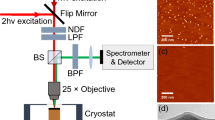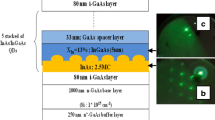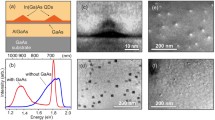Abstract
It is demonstrated that the microphotoluminescence (μPL) spectrum of a single InAs/GaAs self-assembled quantum dot (QD) undergoes considerable changes when the primary laser excitation is complemented with an additional infrared laser. The primary laser, tuned slightly below the GaAs band gap, provides electron-hole pairs in the wetting layer (WL), as well as excess free electrons from ionized shallow acceptors in the GaAs barriers. An additional IR laser with a fixed energy well below the QD ground state transition generates excess free holes from deep levels in GaAs. The excess electron and hole will experience diffusion separately, due to the time separation between the two events of their generation, to eventually become captured into the QD. Although the generation rates of excess carries are much lower than that of the electron-hole pair generation in the WL, they considerably influence the QD emission at low temperatures. The integrated PL intensity increases by several times as compared to single-laser excitation, and the QD exciton spectrum is redistributed in favor of a more neutral charge configuration. The dependence of the observed phenomenon on the powers of the two lasers and the temperature has been studied and is consistent with the model proposed. The concept of dual excitation could be successfully applied to different low-dimensional semiconductor structures in order to manipulate their charge state and emission intensity.
Similar content being viewed by others
References
S. Raymond, K. Hinzer, S. Fafard, and J. L. Merz, Phys. Rev. B: Condens. Matter 61, R16 331 (2000).
U. Jahn, R. Nötzel, J. Ringling, H.-P. Schönherr, H. T. Grahn, K. H. Ploog, and E. Runge, Phys. Rev. B: Condens. Matter 60, 11 038 (1999).
S. Marcinkevičius and R. Leon, Appl. Phys. Lett. 76, 2406 (2000).
M. Grundmann and D. Bimberg, Phys. Status Solidi A 164, 297 (1997).
D. A. Mazurenko, A. V. Scherbakov, A. V. Akimov, A. J. Kent, and M. Henini, Semicond. Sci. Technol. 14, 1132 (1999).
A. V. Akimov and V. G. Shofman, J. Lumin. 53, 335 (1992).
M. Lomascolo, A. Vergine, T. K. Johal, E. Rimaldi, A. Passarelo, R. Cingolani, S. Patanè, M. Labardi, M. Allegrini, F. Troiani, and E. Molinari, Phys. Rev. B: Condens. Matter 66, 041 302 (2002).
J. J. Finley, A. D. Ashmore, A. Lemaître, D. J. Mowbray, M. S. Skolnik, I. E. Itskevich, P. A. Maksym, M. Hopkinson, and T. Krauss, Phys. Rev. B: Condens. Matter 63, 073 307 (2001).
E. S. Moskalenko, V. Donchev, K. F. Karlsson, P. O. Holtz, B. Monemar, W. V. Schoenfeld, J. M. Garcia, and P. M. Petroff, Phys. Rev. B: Condens. Matter 68, 155 317 (2003).
E. S. Moskalenko, K. F. Karlsson, P. O. Holtz, B. Monemar, W. V. Schoenfeld, J. M. Garcia, and P. M. Petroff, Phys. Rev. B: Condens. Matter 64, 085 302 (2001).
E. S. Moskalenko, K. F. Karlsson, P. O. Holtz, B. Monemar, W. V. Schoenfeld, J. M. Garcia, and P. M. Petroff, Phys. Rev. B: Condens. Matter 66(19), 195 332 (2002).
K. F. Karlsson, E. S. Moskalenko, P. O. Holtz, B. Monemar, W. V. Schoenfeld, J. M. Garcia, and P. M. Petroff, Appl Phys. Lett. 78(19), 2952 (2001).
A. M. Wite, P. J. Dean, D. J. Ashen, G. B. Mullin, B. Webb, B. Day, and P. D. Greene, J. Phys. C: Solid State Phys. 6, L243 (1973).
E. J. Johnson, J. Kafalas, R. W. Davis, and W. A. Dyes, Appl. Phys. Lett. 40(11), 993 (1982).
S. Adachi, J. Appl. Phys. 66(12), 6030 (1989).
P. Blood and J. J. Harris, J. Appl. Phys. 56(4), 993 (1984).
M. Heiblum, E. E. Mendez, and L. Osterling, J. Vac. Sci. Technol., B: Microelectron. Process. Phenom. 2(2), 233 (1984); I. H. Goodridge, Properties of Gallium Arsenide (INSPEC, The Institution of Electrical Engineers, London, 1986).
P. Silverberg, P. Omling, and L. Samuelson, Appl. Phys. Lett. 52(20), 1689 (1988).
C. Lobo, R. Leon, S. Marcinkevičius, W. Yang, P. Sercel, X. Z. Liao, J. Zou, and D. J. H. Cockayne, Phys. Rev. B: Condens. Matter 60(24), 16 647 (1999).
K. Mukai and M. Sugawara, in Self-Assembled In GaAs/GaAs Quantum Dots: Semiconductors and Semimetals, Ed. by M. Sugawara (Academic, San Diego, 1999), Vol. 60, p. 183.
Author information
Authors and Affiliations
Additional information
The text was submitted by the authors in English.
Rights and permissions
About this article
Cite this article
Donchev, V., Moskalenko, E.S., Karlsson, K.F. et al. Enhancement of the photoluminescence intensity of a single InAs/GaAs quantum dot by separate generation of electrons and holes. Phys. Solid State 48, 1993–1999 (2006). https://doi.org/10.1134/S1063783406100295
Received:
Issue Date:
DOI: https://doi.org/10.1134/S1063783406100295




